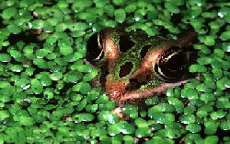for purification
of biogas plants sewage sludge
Taking into account 21. centuries growing need for sustainability (According to Our Common Future (Brundtland Report), sustainable development is defined as development
that "meets the needs of
the present without compromising the ability of
future generations to meet their
own needs."[6][7] ) biological
production and disposal systems are becoming
tremendously important.
Biogas production from
biogene matter on the one
hand and biological sewage purification on the other, are
congenially cooperating for mutual support and humans advantage.
Use of duckweed
and other water plants do
not only meet the necessity of truly practiced
sustainability, but furthermore
is a low cost and real
intelligent and environmentally friendly
alternative to chemical
and other costly sewage treating methods. It's implementation should be a demand for
all responsible members of human society.
SPECIFIC ATTRIBUTES of DUCKWEED
Duckweed (Lemnacea,
Spirodela, Wolfia, Wolffiella) is the smallest higher blooming plant and appears in approx. 40 different
species worldwide.
PRACTCAL USE: see
VIDEO
Water
cleaning ability :
- Duckweed is
optimal for biological
agricultural and communal
sewage purification.
Concentrations of 20-60
mg/l NH4N will be processed
without any problem.
- Up to
42%-67% of total Nitrogen, mainly Ammonium and 56%-95% of
Kjeldahl Nitrogen, (Kjeldahl-nitrogen:
Total Kjeldahl Nitrogen is
concentration of
total N as total amount
of organic bound N and Ammonium-N; TKN = org.N + NH4-N; [mg/L]).
- Resolving and denitrification
of NH3 up to 73%,
- up to
75% of total Sulphur
- up to
9 kg salt/ha/d and
- up to
93% suspended organic
substance will be
taken out of the water..
Space requirements:
- Duckweed need
less space then any other cultivated plant on earth. For same harvest yield they need only 20 % space of that of corn and in comparison to soja it even is only one tenth!
- Because it's
high content of proteins (33-40%, fibre
rate 5%-15%) duckweed suits
perfectly as fodder plants. Duckweeds
proteins do have higher concentrations of trace elements,
essential aminoacids, Lysins and Methionines as most other plants proteins und resemble animals proteins better then any other. Duckweed from heavy metal free waters are without hesitation fit for human consumption.
Projects on that are
run.(Belgien,
Holland, USA).
· Duration times:
in tropical regions: 7-20
days
in meridian regions: summer: 20-40 days, winter: 60-120 days.
· Dimensions: 125-280 m3/day
in 0,2 ha
for mainly fodder production: ca. 0,3-1 m deep,
for mainly water purification: to 3 m deep.
Growth:
- Lemnacaeen are
one of the fastest growing plants
organisms in the world.
- For their
growing they need large concentrations of nutrients, especially Nitrogen.
- Under optimal conditions
they double their space within less then 2 days.
So 1 m2 can cover 1
ha within about 14 days.
Harvest yield: 7,4-21,4 g/m2 per day
or 27-80 ton/ha can be harvested per year.
· Opt. growing temperature: 6°-33° Cel.; Optimum: 20°-30° Cel
· PH degree: 5-9; Optimum: 6,5-7,5
· Optimal density: 0,6-1,2 kg/m2
A frog
in duckweed -- Image courtesy
of Cross, J.W. (1999), The charms of Duckweed
(27 Mar. 2000)

Sources: - FAO; FOOD AND
AGRICULTURE ORGANIZATION OF THE UNITED NATIONS
- UNEP; UNITED NATIONS ENVIRONMENTAL PROGRAM
- THE WORLD BANK EMENA TECHNICAL DEPARTMENT AGRICULTURE DIVISION
- Univ. of Tropical Agriculture
Foundation, Finca Ecologica,
Univ. of Agriculture and Forestry, Thu Duc, Ho Chi Minh City, Vietnam
1.
World Commission on Environment and
Development defines sustainability
as: "... to guaranty, that development meets the present demands,
without diminishing the ability of
following generations, to meet their
own demands". (back to text)
|